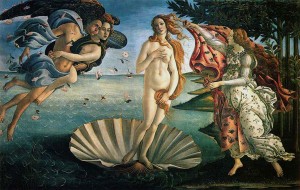So yesterday I came across a little video Prager University made about modern art, namely why it’s so “bad.” Featuring artist Robert Florczak, the video states that modern art is merely a “competition between the ugly and the twisted” where the “most shocking” artwork wins. While I agree with some of Florczak’s points, I personally can’t agree with his argument at all.
Here’s the link to the video on YouTube (I apologize– the embed code was acting a little off so it may not play here)..
First of all, Florczak makes the statement that his argument about the whole of modern art being tasteless is not a matter of personal taste–but then goes on to denounce anyone whose personal taste doesn’t line up the Renaissance works he champions. His claims about classical art as the “universal standard” are also a bit troubling, as the classical art pieces he references as great are strictly Italian Renaissance pieces. This “universal” standard leaves no room at all for other non-Western artists to have their work even considered. Florczak goes on to decry modern art as pornographic–which is true for some pieces–but then chooses to ignore the thousands of classical nudes coming out of Western tradition (and uses Botticelli’s Birth of Venus as his example, which I find a bit ironic).

In addition, the “universal standard” that Florczak uses to call out modern artists is a bit flawed. He claims that classical art’s standard lies in its attempt to be universal, which is of course true. But as the world grew larger with time and technology, people began to realize that what they traditionally thought of as a universal artistic vocabulary wasn’t actually so and worked to remedy that. By the time the 20th century rolled around, people like the Russian Suprematist artists (not a racist group–they’re called Suprematists because they thought of art as transcendent and supreme, more so than language or identity) began to think that the only way they could produce art that would resonate universally with all people was pure abstraction. Hence the Kazimir Malevich painting White on White that Florczak denounces as merely background at the video’s end: in actuality, this is Malevich’s attempt at a work of art that through pure color (as opposed to Greco-Roman, Judeo-Christian iconography) will resonate with all cultures. Ironically, what Malevich is aiming for is exactly the opposite of what Florczak criticizes him for–making what should be universal into something personal is what he’s trying to avoid.

I’m not entirely sure what Florczak is categorizing as “modern art,” either. Modern art is a broad term under which art from 1900-around the 1950s generally fits. But with his reference to the 2012 piece Levitated Mass (i.e. the giant rock) it seems as if he’s criticizing contemporary art as well, contemporary art being another large subheading under which works from the 1960s onward are generally lumped. Modern art is generally more critically charged because it’s where people and movements like Marcel Duchamp (who’s quoted as wanting to “destroy art”) and the Dada movement (more focused on gently mocking our conceptions of art) fall. The art produced in this period seems parts with traditional ideals of what makes good art for a number of reasons, and it’s not a sudden shift–notice how it’s about 50 years. Contemporary art is harder to define because it is incredibly pluralistic and

still occurring. But from what I can gather, Florczak is criticizing both. So if Florczak is actually meaning to criticize all art from 1900 onward, that’s problematic as well–he’s suggesting that 100 years’ worth of art is worthless!
Florczak does have some spot-on points, though. He states that the classics should be taught in schools (*cough* Art Docent Program! Woo! *cough*), and that art education should be a priority. His statements that art museums and galleries should not necessarily dictate what art “counts” is true. While museums and galleries are awesome places that make great works accessible to the common people, they do have a much larger influence than any of us would imagine. But I suppose it’s better than the state deeming what counts (the French Academy, anyone?). Florczak also mentions that LACMA spent 10 million dollars on Levitated Mass, and blames the art community at large. I happen to come from the general area where artist Michael Heizer got the “giant rock” from, so I get that perhaps transporting the rock cost a lot. But 10 million dollars? That’s obscene. And it’s not just Levitated Mass commanding such a high price–the art world is full of modern works being auctioned for millions. As much as modern and contemporary art claims to decry elitism, the fact that the best and brightest modern and contemporary artists have dealers willing to sell their works for this amount of money tells a different story. The price has become the standard by which works are deemed good or bad, and this is completely wrong.
I understand Florczak’s struggle–I really do. Believe me, sometimes I’d much rather look at a gorgeous Botticelli than a Duchamp readymade. Both are dealing with interesting themes, but for me, Botticelli is easier on the eyes, much less angsty, and easier to grasp. Yes, modern and contemporary art pieces are a departure from what I’m familiar with and can be confusing. I might not even like some of what I see. But I’m not going to dismiss and discredit over one hundred years of art just because I don’t like it. Modern and contemporary art is hard, and finding a standard by which to judge it is a huge question that art historians are faced with, especially in today’s world of global, pluralistic art. Sometimes answers are hard to find. But that’s not going to stop art historians from trying.
And what of the teaching of art appreciation? Ought we to only teach Renaissance and Baroque art? Well, here at the Art Docent Program, we love these periods! However, we’re not going to discriminate against modern art movements like Cubism or Surrealism, because they’re key to the 20th century history of art and our understanding of today’s art. There’s a lot to be learned from any era of art, and shying away from something just because it’s different isn’t cool.
Alright! Soapbox rant over. Have different thoughts? Let me know in the comments below!
Oh, and p.s.–take a look at Robert Florczak’s website here. The art he’s producing may be done in a neoclassic medium (paint), but deals with modern subjects and Surrealist color patterns. Which are accepted and common in some contemporary art circles. Just sayin’.







